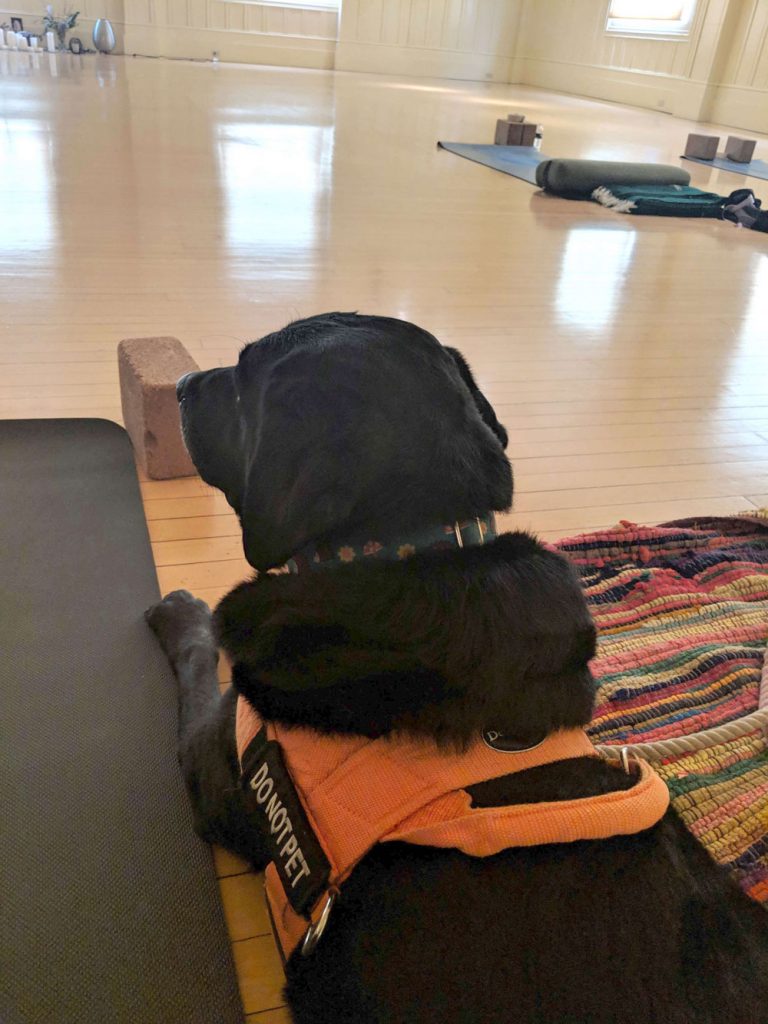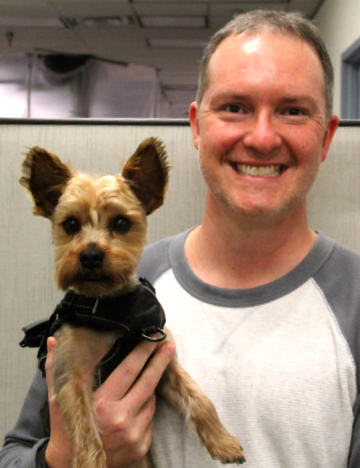In and outside the workplace, service animals perform essential duties. They are not pets. So, while most people enjoy petting a friendly puppy, any interaction with these hard-working animals could put them and their handlers at risk. Service dogs are trained to tune out distractions.
At Sandia, animals in the workplace are there to assist their handlers. All other employees are advised to simply ignore them — no petting, calling, clicking or touching their equipment. In other words, “no touch, no talk, no eye contact.”
Meet Mags

Magnum, who also goes by Mags, is a service dog, an extension of a Sandia employee who is a more productive member of the workforce, thanks to the special relationship that they share.
“One reason I’m so passionate about increasing public knowledge and understanding regarding service dogs is because handlers depend on them so heavily. They’re essential medical equipment and a vital part of a handler’s independence and ongoing safety,” said Mags’ handler Kate Moore, an office management assistant at Sandia. “If a service dog is injured and no longer able to work, which can happen when other animals encountered in public are not properly trained or restrained, obtaining a replacement can take years, putting the handler’s health at risk.”
Service dogs require extensive training before being placed with a handler and even more training once their working career begins.
“As examples, service dogs may be specifically trained to pick up items, give an alert about a chemical change or ensure a handler remains immobilized during a medical episode,” Kate said. “So, a distracted service dog creates a potentially dangerous situation. A missed task due to someone’s intrusive behavior could be life-threatening for the dog’s handler.”
Because service dogs travel with their handlers just about everywhere, they are expected to have perfect or near-perfect obedience and are taught to be unobtrusive and to stay out of the way. Kate also said handlers may use a wide array of different kinds of gear for their dogs. She likes a gentle leader wrapped around the dog’s nose so they can better anticipate each other’s movements.

Meet Bear
Bear, a 4-year-old Yorkshire terrier, is a service dog at Sandia’s California campus.
“When they see me, people know that together Bear and I are a team,” said technologist Jim Holtman. “He goes with me everywhere. We share a deep bond.”
Service dogs are sometimes trained by their owners. After Jim learned techniques from an experienced trainer-handler, he became Bear’s trainer-handler. Around Sandia, Jim mostly keeps Bear on his left-hand side and walks on the left side of hallways. He finds it helpful when workforce members, whether coming toward them or passing, stay on the far side of the hallway from Bear. Doing so allows the service dog to stay focused on his work.
Jim said training the public on proper etiquette when around a service dog can be challenging.
“People will run up to Bear, thinking he can be petted or given treats like he’s just a pet dog,” he said. “My closest coworkers, however, understand and accept his role as my service dog, and because we all work in tight quarters, many hours a day, several days a week, having Bear with me reduces stress, helps keep me motivated and improves productivity, which benefits our entire team. While Bear loves interacting with people, he seems to know that when he’s wearing his vest, he’s on duty.”
A handler’s right to privacy
Drawing attention to the handler and animal by staring, pointing or calling out is inappropriate behavior. Employees should avoid asking handlers what services their animals perform or any personal questions.
“Service dogs are now part of the Sandia workforce team,” explains Bonnie Breznik-Young, the Sandia/California absence management administrator. “The animal’s owner and management follow a specific process of medical determinations, agreements and accommodation discussions before the dog arrives on-site.”
Bonnie advises employees to avoid asking handlers questions or making comments, such as the following:
- Are you sick?
- Good boy or good girl.
- Why do you get to have your dog at work?
- What kind of dog is that?
In circumstances where a disability necessitates a service animal, an employee can request, verbally or in writing, accommodations from immediate management, the appropriate human resources business partner, Employee Health Services or the job accommodation specialist. The employee must then provide EHS-requested medical information and participate in discussions with management about needed accommodations.
Each service animal agreement is signed by the employee, their manager, Sandia’s occupational safety and health manager, and a physical security systems representative. An assessment will be conducted to identify any issues or concerns with accommodating the service animal. If mitigations are needed, an appropriate plan will be developed.
Concerns such as shedding and allergies are not reasons for refusing service animals in the workplace, according to the Americans with Disabilities Act. In addition to being responsible for keeping their dogs groomed and brushed appropriately for the breed and the season, employee handlers must agree to apply regular flea and tick preventatives to their service animals. Moreover, a nearby employee’s allergies can be addressed by separating the workspaces. Designated pet relief and waste disposal locations will be established, and each handler is responsible for ensuring proper cleanup and disposal.
For additional information about service animals at Sandia, contact Bonnie Breznik-Young in California or Tammy Sanchez-Godin, the New Mexico job accommodation specialist. For more general information about service animals, see the Americans with Disabilities Act website.